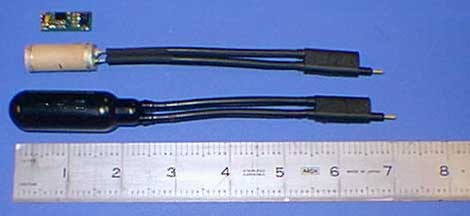Technology Tutorial Introduction
People use sound in the ocean for a wide variety of purposes. Many important everyday activities, such as fishing, depend on sound for success. This tutorial introduces a variety of technologies for measuring and employing sound in the ocean. Additional content about how people use sound in the ocean is available in the People and Sound section, and additional information about technology used in the ocean in available in the Technology Gallery.
Hydrophone / Receiver
A hydrophone is an underwater listening device. Just as a microphone is used to detect sound in the air, a hydrophone detects sounds in the water and converts the acoustic energy into electrical energy. Hydrophones listen to sounds in the sea, but do not transmit any sound, making them passive listening devices.
Most hydrophones are made from a piezoelectric material. This material produces small electrical charges when exposed to pressure changes. The pressure changes associated with a sound wave can be detected by a piezoelectric element. Under the pressure of a sound wave, the piezoelectric element flexes and in return gives off electrical signals. These electrical signals can be recorded and later analyzed with computer programs.

Photograph of a standard hydrophone. The upper picture is the preamplifier. The center picture is the ceramic element/preamplifier assembly (the preamplifier is housed inside the ceramic element). The lower picture is the final product that is encapsulated in urethane. Photo courtesy of Adrienne Spychalski, High Tech, Inc. (http://hightechincusa.com/)
Hydrophones are specially designed for underwater use. They are normally encased in a rubber boot to provide protection from seawater. Hydrophones can be mounted in several different ways. They can be attached to a boat, towed, or placed in a fixed position underwater.
A hydrophone array is made up of a number of hydrophones placed in known locations. These hydrophones maybe placed in a line on the seafloor, moored in a vertical line in the water column, or towed in a horizontal line behind a boat or ship, for example. Sound arriving at the array from a distant source, such as a submarine, will reach each hydrophone at slightly different times, depending on the direction from which the sound is coming. This time difference is known as the time-of-arrival-difference and can be turned into a direction. Using this information from all the hydrophones in the array, the direction from which the sound is coming can be pinpointed.
